Georgetown Mews ACEE Summer Case Study
Integration of Energy Management, Electrical Submetering and Time Sensitive Pricing in a Large Residential Community Utilizing Wireless Communications
Paper #703
Paper to be presented at the 2008 Summer Study on Energy Efficiency in Buildings Workshop organized by the American Council for an Energy-Efficient Economy (AEEE), August 17–22, 2008
Abstract
In this paper, we present a demonstration project in which advanced metering and communications technology, time-sensitive pricing, sensors and control systems are combined cost-effectively in a unique way to enable multifamily apartment residents, owners, the utility grid and society to achieve reduced energy consumption and demand, and take full advantage of incentives available from NYSERDA programs. Along the way, a number of significant barriers were overcome. Specifically, the project involves a 37 building garden apartment complex covering over 60 acres in Queens, New York, where a project team of consultants and technology vendors integrated an advanced 2-way wireless data communications system, electrical submetering, a 3-period time-of-use rate, apartment temperature sensors, boiler control and room air conditioner controls. The installation addresses the unique barriers of garden apartment complexes by consolidating data from all 930 individual apartments and 33 utility master-meters. In addition, the apartment meters use a color-coded LED display to inform residents of the TOU price period, temperature sensors transmit information to the boiler control system and integrated controls are planned to enable control of room air conditioner units during hot summer days. Projected reductions in apartment sector electric consumption and demand are 20% and in overall building heating fuel consumption at 10%. Additional incentives are also anticipated from NYISO for demand response activities, such as critical day load curtailments. This NYSERDA project is expected to be a model for integrating multiple energy and demand reduction measures in multifamily buildings, especially garden apartment complexes, which have entailed significant barriers to energy savings measures, particularly electrical submetering, in the past.
Background
With the increasing cost of energy, difficulty in siting power generation, environmental concerns and uncertain fuel supplies, there has been a renewed interest in reducing energy consumption, especially wasteful practices. Both New York State and New York City have recently announced significant energy and greenhouse gas reductions targets. Over the past 25 years, efforts to address this in the multifamily residential sector in New York, a major – but underserved - sector with over one million apartments, have advanced technology and overcome many barriers. Most notably, technologies and programs to facilitate the implementation of electrical submetering in master master-metered buildings1 that enable billing of apartment residents for what they use, have been the focus, with results establishing its feasibility, value and cost-effectiveness. More recently, several case studies have utilized NYSERDA, utility and New York ISO incentives to augment submetering with measures that achieve additional savings in innovative ways, providing benefits to all stakeholders.
Electrical submetering was reinstated in New York State by the Public Service Commission (PSC) during 1979 in an effort to promote conservation and decrease dependency on foreign oil. Most of the large multifamily residential buildings under the jurisdiction of various New York agencies, namely, the New York State Division of Housing and Community Renewal (DHCR) and the New York City Department of Housing Preservation and Development (HPD) were constructed as master metered buildings during the 1950s and 1960s due to the lower construction costs and the relatively low cost of electricity. In order to ensure that the submetering equipment available to these supervised buildings was both reliable and accurate, the New York State Energy Research and Development Authority (NYSERDA), in association with DHCR, initiated the “Demonstration of New Submetering Technologies” Project in 19802. The first meaningful program within New York State designed to promote the implementation of electrical submetering was by the Consolidated Edison Company of New York (Con Edison)3 from 1990-1995. The program achieved moderate success but did not meet the full expectations which were anticipated at the inception of this program due to the myriad of barriers to implementation which were encountered while the program was conducted. When New York State began deregulation of electricity in 1995, NYSERDA4 was assigned to oversee research, development and deployment of energy conservation programs which were previously the responsibility of separate utilities within the State. In its new role, NYSERDA concluded that for submetering to be successfully implemented, it would be necessary to identify barriers and devise means for overcoming them. To achieve this goal, NYSERDA sponsored the “Facilitating Submetering Implementation” Program5.
Two major barriers which were identified and subsequently addressed by actions were:
- The PSC initially required approval by the majority of shareholders or apartment owners in cooperatives and condominiums for submetering to proceed. Due to the lack of involvement by the majority of shareholders or apartment owners in these type residential buildings, it became very difficult to meet this voting requirement. The PSC subsequently amended this in 1996 to require approval of only a majority of shareholders or apartment owners that actually participate in the voting process.
- A lack of understanding of the submetering process, submetering technologies and impact on residents regarding the installation of submetering equipment complicated the evaluation process by building owners and/or Boards of Directors. To address this lack of educational material, NYSERDA funded the development of the Residential Electrical Submetering Manual6 and contracted for the development of the website www.submeteronline.com.
In 1999 NYSERDA followed this with the “Submetering in Multifamily Buildings”
Program which provided technical assistance to residential buildings during their evaluation of
electrical submetering7. Broadening the program to reflect more advanced metering options,
NYSERDA then developed the Comprehensive Energy Management (CEM) Program which
provided similar technical assistance to residential buildings as well as financial incentives to
offset advanced metering (including submetering) implementation costs. These incentives
generally covered 50% of implementation costs for Fair Market buildings and 60% of
implementation costs for Affordable Housing 8buildings. Under the CEM program, the
submetering equipment which was eligible for financial incentives was required to meet the
NYSERDA’s newly developed specifications for Advanced Metering equipment, which included
providing for transmission of interval master-meter data to a NYSERDA data collection center.
Data would thus be available for purposes of analyses as well as designing load profile, load
reduction/curtailment, and time sensitive pricing programs to further expand the energy
conservation capabilities associated with submetering. This requirement was generally not a
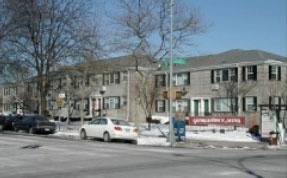 problem for large residential or high-rise buildings with a relatively high ratio of apartments to
building master meters. However, in garden-apartment type complexes, where multiple low-rise
buildings are spread out over a large geographical area and which comprise a significant
percentage of building types within New York State, there is a relatively low ratio of apartments
to building master meters and multiple
utility owned building master meters. In
such instances, building to building
communications becomes more
problematic, and the number of
communication devices (modems, DSL
lines, etc) increases substantially, thereby
increasing submetering implementation and
monthly operating costs significantly for
these types of buildings in order to comply
with NYSERDA eligibility requirements
and receive incentive funding9.
problem for large residential or high-rise buildings with a relatively high ratio of apartments to
building master meters. However, in garden-apartment type complexes, where multiple low-rise
buildings are spread out over a large geographical area and which comprise a significant
percentage of building types within New York State, there is a relatively low ratio of apartments
to building master meters and multiple
utility owned building master meters. In
such instances, building to building
communications becomes more
problematic, and the number of
communication devices (modems, DSL
lines, etc) increases substantially, thereby
increasing submetering implementation and
monthly operating costs significantly for
these types of buildings in order to comply
with NYSERDA eligibility requirements
and receive incentive funding9.
As a result of this significant cost barrier, the percentage of submetering implementation
in garden apartment complexes has remained low and NYSERDA has continued to fund research
for solutions which address these issues and improve the ability of these buildings to proceed
with implementation. 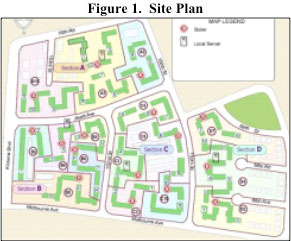 It was under the NYSERDA CEM Program that technical assistance and
incentive funding was made available to Georgetown Mews, the garden-apartment type
residential building complex which is the
subject of this paper. The evaluation of
this demonstration project was separately
funded by NYSERDA R&D10.
It was under the NYSERDA CEM Program that technical assistance and
incentive funding was made available to Georgetown Mews, the garden-apartment type
residential building complex which is the
subject of this paper. The evaluation of
this demonstration project was separately
funded by NYSERDA R&D10.
Building Complex Description
Georgetown Mews (pictured) is a cooperative complex, consisting of thirty seven (37) 2-story low-rise (garden type) residential buildings with a total of 930 apartments occupying approximately sixty (60) acres in Kew Gardens Hills, Queens, New York. This residential complex is master metered by thirty three (33) individual utility (Con Edison) owned utility meters and contains sixteen (16) individual boiler rooms located throughout the complex which provide hot water to the buildings for apartment space heating and domestic hot water (DHW). Apartment cooling is facilitated by resident owned through-the-wall air conditioners of varying size and capacities. This complex is subdivided into four sections which are separated by streets which support significant traffic (refer to Figure 1). Approximately 85% of the apartments are occupied by shareholders, with the balance occupied by rent stabilized apartments under the jurisdiction of the Office of Rent Administration of DHCR. Georgetown Mews Owners Corporation owns the apartments occupied by the rent stabilized tenants.Problem Statement and Proposed Solution
As previously mentioned, many residential buildings throughout New York State have been unable to cost-effectively implement existing submetering technologies due to inherent communications limitations and their associated high cost. This is often the case in garden type apartment complexes which are usually spread out over substantial areas, often with varying
topographies, separated by streets and clusters of trees,
and frequently contain numerous utility owned master
meters. Furthermore, without two-way communications as
required for transmitting submetering data, there is no
reliable means to effectuate central load control of
individual apartment heating and air conditioning
equipment. Additionally, if existing apartment air
conditioners cannot be centrally (or fleet) controlled, there
is no mechanism to effectuate widespread demand control
and the ability to participate in an effective load
curtailment program. Finally, reliable communications is
required to transmit and collect submetering data in short
enough time intervals to facilitate time sensitive pricing.
over substantial areas, often with varying
topographies, separated by streets and clusters of trees,
and frequently contain numerous utility owned master
meters. Furthermore, without two-way communications as
required for transmitting submetering data, there is no
reliable means to effectuate central load control of
individual apartment heating and air conditioning
equipment. Additionally, if existing apartment air
conditioners cannot be centrally (or fleet) controlled, there
is no mechanism to effectuate widespread demand control
and the ability to participate in an effective load
curtailment program. Finally, reliable communications is
required to transmit and collect submetering data in short
enough time intervals to facilitate time sensitive pricing.
With the use of advanced metering currently employed by buildings which participate in the NYSERDA CEM program there is a requirement to remotely retrieve all master meter(s) interval data, as well as individual apartment submeter(s) data. To satisfy this NYSERDA requirement, in such a multi building complex with a multitude of utility meters, typically requires complex communications systems, via either numerous DSL or phone lines, with associated monthly charges which can adversely affect the economic benefit of implementation. It should be noted that failure to meet these NYSERDA CEM requirements precludes the buildings from receiving incentives predicated on advanced metering criteria, thereby serving as a disincentive to implement submetering.
 The integrated system proposed and subsequently installed11 at Georgetown Mews to
address these issues consisted of an Intech 21 web enabled building-to-building communications
system (utilizing custom directional and multi-directional
antennas and interconnecting cabling and network nodes – refer to
Fig. 2, 3, and 4) that successfully transmits individual apartment
submetering data in 15-minute time intervals. This eliminated the
need for multiple communications systems to satisfy each of the
33 utility master metered buildings, reducing the system to only
four sections (See Figure 1 – Site Plan) with each section being
provided with a separate DSL communications sub-system which
will greatly reduce the monthly maintenance costs for this
submetering system.
The integrated system proposed and subsequently installed11 at Georgetown Mews to
address these issues consisted of an Intech 21 web enabled building-to-building communications
system (utilizing custom directional and multi-directional
antennas and interconnecting cabling and network nodes – refer to
Fig. 2, 3, and 4) that successfully transmits individual apartment
submetering data in 15-minute time intervals. This eliminated the
need for multiple communications systems to satisfy each of the
33 utility master metered buildings, reducing the system to only
four sections (See Figure 1 – Site Plan) with each section being
provided with a separate DSL communications sub-system which
will greatly reduce the monthly maintenance costs for this
submetering system. 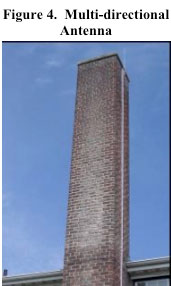
Individual submeters were installed inside each apartment at additional cost, as opposed to adjacent to dedicated apartment circuit breakers in the basement area. This allowed it to take full advantage of an integral apartment temperature sensor which would be utilized to develop control algorithms to optimize the heating distribution system, which includes 16 individual boiler rooms, at Georgetown Mews.
The 16 existing boiler controls were replaced by an
Intech 21 controller (refer to Fig. 5), which is also compatible
with the installed communications network, 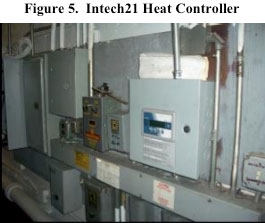 and can be operated
based on control algorithms derived from input from the
individual apartment temperature sensors as opposed to only the
ambient temperature.
and can be operated
based on control algorithms derived from input from the
individual apartment temperature sensors as opposed to only the
ambient temperature.
In addition, each of the individual apartment submeters with integral temperature sensors contains three color LEDs depicting each of the three time periods which pertain to the time of use pricing schedule (refer to Fig 6). The red light depicts a Peak Pricing Period (most expensive electricity); the yellow light depicts a Shoulder Pricing Period (moderately expensive electricity) and the green light depicts an Off- Peak Pricing Period (least expensive electricity). The LEDs provide indication to the apartment resident which pricing period is in effect to assist him/her in modifying his/her usage patterns in accordance with the schedule depicted in Figure 7. The intent of the LED feature is to reduce peak usage and shift the overall Figure 6. Typical apartment submeter with LED lights demand to Off-Peak periods, thereby saving the apartment resident some money and working toward eliminating the threat of power outages caused by excessive peak demands on the utility grid.
To satisfy one of several NYSERDA project objectives, Intech 21 and a selected air conditioner manufacturer (to be selected) were to jointly develop and provide up to 100 individual through-the-wall room air conditioners which would be centrally (fleet) controlled utilizing the installed communications network, as well as being individually controlled by utilizing the integral apartment temperature sensor as a thermostat.
The air conditioner control and communications
module package, which is installed as part of the chassis, was
developed by Intech 21 and includes a multitude of capabilities
to provide maximum flexibility in applying various control
strategies. For example, the ability to control the compressor
separately from the air conditioner recirculation blower and
the ability to remotely adjust the thermostat setting to
effectuate fleet load control, reduce usage and demand and
minimize tenant inconvenience were also primary design
objectives of this project.

Overcoming Barriers
As indicated, a retrofit project like this encountered a number of significant barriers that had to be overcome before successful implementation. Getting this project off the ground while addressing these barriers involved about three years of effort, and culminated in an atypically short implementation period of only 6 months for actual installation, excluding the air conditioners, which are planned for the 2008 summer season. These barriers included:
1. Economic Cost-Effectiveness Justification
As mentioned, the data communications system, configured for the building complex, combined wireless data communications, consolidation of the 33 master-metered data nodes into four networked nodes, and incorporating additional energy and cost-saving features, including temperature monitoring for boiler control and associated fuel and operational savings, time- sensitive pricing, and capability for load control to take advantage of incentives for demand response improved the cost-effectiveness considerably. In order to take full advantage of NYSERDA incentives for advanced metering, rather than use conventional electro-mechanical meters installed in each building basement capable of only submetering (which would preclude any non-submetering features and associated savings and not qualify for NYSERDA incentives), a more advanced (and NYSERDA-qualified) system was installed, with meters in each apartment that incorporated temperature sensors and LEDs that signaled residents as to the time- of-use rate price level. The temperature sensors provide operational savings since building complex-wide temperature monitoring can be done from a central location by operations staff. NYSERDA deployment funds paid for a significant share of meters, data communications, boiler control equipment and associated installation under their deployment initiative. NYSERDA R&D funds covered communications enhancements, meter upgrades to include LED TOU signals, time-of-use billing and the air conditioner control capability. The time-of-use rate and billing system adopted for the project was already developed through an earlier NYSERDA R&D project with Clinton Hill Apartments in Brooklyn, NY, in which a three-tier time-of-use rate (refer to Fig. 7) was applied and associated time-of-use billing system developed12.
The savings associated with reduced energy consumption and demand anticipated for submetering and boiler control, plus additional savings associated with the TOU rate and potential for demand response from air conditional control, combined with the cost savings from operational efficiencies from the temperature monitoring and project installation funding from NYSERDA, ensured that the project was cost-effective, with a short enough payback period to satisfy all stakeholders.
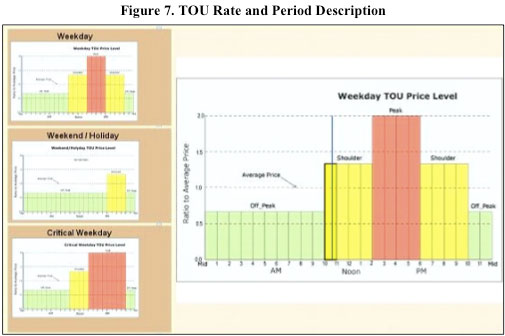
2. Regulatory Barriers
Approximately 85% of the apartments are occupied by shareholders of the Cooperative. The balance of the apartments are owned by the Georgetown Mews Owners Corporation and occupied by rent-stabilized tenants. Institution of submetered billing for the rent-stabilized apartments requires regulatory approval from both the PSC and DHCR. In order to avoid the lengthy DHCR approval process, it was decided to exclude the rent-stabilized tenants from the submetering process13. Also, excluding the rent-stabilized tenants from the submetering process eliminates significant opposition and actions which substantially delays the implementation process. Occupants of these apartments will not be billed for electric charges until the apartment is sold and becomes a shareholder-occupied apartment.
3. Resident and Political Opposition
It is common practice for residents who oppose submetering to reach out to their local politicians in an attempt to derail the process. Their objections, however, are often based on misconceptions and self-interest. Many of the politicians do not fully understand what submetering is (and its benefits) and are generally motivated by their obligation to satisfy their voting constituents. In the appearance of acting on the behalf of their constituents, these politicians involve other regulatory organizations who are intimidated and obligated to further investigate specific applications which, in turn, further delays the approval process. These actions often create substantial delays which, in combination with internal pressures exerted by residents who are opposed, may discourage owners and Boards of Directors from proceeding with the implementation.
In order to overcome typical misconceptions and minimize opposition at Georgetown Mews, an educational and outreach campaign was conducted by the Board of Directors, management and building consultant that included a series of meetings with representatives of the State Assembly, State Senate, City Council and Congress. An additional workshop was conducted for all the shareholders and informational materials were prepared and disseminated to all shareholders. NYSERDA participated in the process.
These efforts, which occurred over a three year period, were critical in achieving
shareholder approval and cooperation during both the voting and installation process, which
required access to apartments for the one-time installation of the apartment submeter, which is
often a protracted process. In retrospect, the efforts to address the technical requirements of this
project are dwarfed by the effort required to obtain approval and cooperation, which was aided
by experience in previous projects – some successful and some not.
Project Monitoring and Verification and Applicability
The NYSERDA project is intended to collect data on electric consumption (energy and demand), heating consumption (fuel oil), and assess the impacts, cost reduction and overall cost- effectiveness in order to provide an example case study for similar installations. It is estimated that several hundred thousand apartments in New York State are similar to those in Georgetown Mews.
Georgetown Mews consumes over 5 million kWh annually and it is anticipated that the combination of electrical submetering and apartment air conditioning control should result in an annual reduction in electrical usage of at least 1 million kWh (20%). It is also anticipated that the peak demand at Georgetown Mews, which is approximately 2,000 KW, will be reduced by approximately 400 KW (20%).
Additionally, Georgetown Mews which consumes over 1 million gallons of heating oil
annually should reduce its fuel consumption by a minimum of 100,000 gallons (10%). These
annual reductions in energy costs should justify the implementation of these conservation
measures. The economics can be further improved by incentives available from Georgetown
Mews’ participation in New York State ISO Curtailment programs, including ICAP once the
fleet-controlled air conditioner load control are installed and operational, planned for summer
2008.
Conclusions and Next Steps
To date, the project can be considered a success, in that implementation has been accomplished and the infrastructure in place to facilitate the energy and demand savings envisioned. A major objective of the project was achieved in that the system has successfully communicated with each and every one of the 930 apartments and sixteen boiler rooms located throughout the 60 acre residential community. The director of maintenance has already benefited from the operational efficiency improvements attributable to the web-enabled heating control system and apartment temperature sensor monitoring.
This case study is intended to provide guidance to energy professionals who seek to
implement similar projects and must assess technology and overcome barriers such as those
encountered here. The three year process of preparation and design would surely inform anyone
undertaking a similar project. A subsequent paper is planned to present the results of the project,
in terms of energy and demand reduction, regulatory acceptance, and resident satisfaction.
Acknowledgements
The author wishes to acknowledge the assistance of the NYSERDA Project Manager, Peter Douglas, project team members (Zach Stern of Elemco Building Controls, Victor Zelmanovich and Beila Kolb of Intech21, Yemi Kuyoro of Abitype Business Services), Georgetown Mews (Robert D’Amico, Peter Worko, Mary Fischer) and their Mark. Greenberg Management Company (Jim Goldstick) and Joseph S. Lopes of Applied Energy Group, Inc.
Georgetown Mews would like to thank Assemblywoman Nettie Mayersohn, Senator Toby
Stavisky and Congressman Anthony Weiner.
References
Hirschfeld, P.E., Herbert E., Howard Schechter, Ruth Lerner, Joseph S. Lopes and Fredric Goldner. 1996. Facilitating Submetering Implementation, NYSERDA Report #96-7.
Hirschfeld, P.E., Herbert E., Howard Schechter, Ruth Lerner and Joseph S. Lopes. 1997.
Residential Electrical Submetering Manual, published by NYSERDA in October 1997.
Foot Notes
1 Master-metered buildings are defined as those with one (or more) utility meters measuring and billing for only the whole building but not each individual apartment. Submetering (or sometimes referred to as checkmetering) is a process whereby meters are installed for each apartment in either the apartment or a common area that enables the building owner to meter and allocate utility electric charges to individual apartment residents in proportion to their actual consumption rather than apartment size or shares in a Cooperative.2
Demonstration of New Submetering Technologies Report (NYSERDA Report 86-8), published October 1986 by
Hirschfeld & Stone Consulting Engineers. The major results of this study were:
a. State of New York adopted ANSI C-12.1 as the standard for submetering equipment;
b. The conservation benefit of submetering was quantified at between 18% to 26% of the electrical usage in the
apartment sector of master metered buildings;
Power line carrier (PLC) technologies were demonstrated as viable techniques for communicating submetering data
in residential buildings.
3 Con Edison funded the Submetering in Residential Buildings Program during 1990 through 1995. The program was conducted by Xenergy, Applied Energy Group and Herbert E. Hirschfeld, P. E. Under this program, feasibility evaluations, educational meetings as well as financial incentives were available to participating residential buildings during the evaluation of and implementation of electrical submetering.
4 New York State Energy Research & Development Authority (NYSERDA) was assigned by The New York State Public Service Commission as responsible state agency and initiated a system benefits charge (SBC) collected by the utilities to fund NYSERDA’s role.
5 Facilitating Submetering Implementation, NYSERDA Report #96-7 conducted May 1996 by Herbert E. Hirschfeld, P. E., Howard Schechter, Ruth Lerner, Joseph S. Lopes and Fredric Goldner.
6 Residential Electrical Submetering Manual, published by NYSERDA in October 1997 by Hirschfeld, Schechter, Lerner and Lopes.
7
Submetering Multifamily Buildings Program was conducted between 1999 and 2002 by Herbert E. Hirschfeld,
P.E. The services provided included:
a. Preparation of Electrical Submetering Technical/Economic Feasibility Evaluations;
b. Meeting with building owners, Boards of Directors and residents for educational purposes;
Assist residential buildings obtain regulatory approval from such agencies as PSC, DHCR and HPD.
8 Generally speaking, Affordable Housing represents either low income or subsidized housing while Fair Market represents the balance of housing types
9 The utilization of conventional electro-mechanical meters which require on-site manual readings represent an alternative solution for submetering garden-apartment complexes; however, because these installations are ineligible to receive NYSERDA incentives for failure to meet the advanced metering requirements, many garden-apartment type complexes are reluctant to proceed with submetering. Additionally, the lack of advanced metering precludes time sensitive pricing and limits participation in New York State Independent System Operator (ISO) load curtailment (ICAP) programs.
10 Contract for “Load Management Demonstration in Multifamily Housing” awarded to Herbert E. Hirschfeld, P. E.
11
Installation commenced in June 2007 and completion to date includes:
a. Communication system comprising directional antennas, multidirectional antennas for each of the four
building sectors, interconnecting cabling as required, all network nodes and 4 DSL lines/associated servers
b. All apartment submeters
c. All advanced master meters in parallel with utility master meters (in lieu of KYZ pulses)
d. All replacement boiler controllers compatible with communications system
e. The website and associated software programming
12 The three-tier, or “Traffic Light” rate concept was developed by Joseph S. Lopes of Applied Energy Group, Inc. for the Clinton Hill Project (NYSERDA Agreement 7572 – 2003-2007). It applies a fixed price ratio of peak to shoulder to off-peak period usage of 3 to 2 to 1, respectively, for allocating total energy costs based on peak period of 2-6 pm weekdays, shoulder period of 10am-2pm and 6-10pm weekdays and 6-10pm weekends, with all other hours off-peak. As described, an additional critical peak period of 6-10pm for peak during likely summer critical days may be applied to the Georgetown Mews project.
13 Rent-stabilized tenants will not be billed for electric charges. Bills for the rent-stabilized apartments will be the responsibility of the owner of these apartments, the Georgetown Mews Owners Corp., which charges rent that includes electric, which is not based on actual usage.
